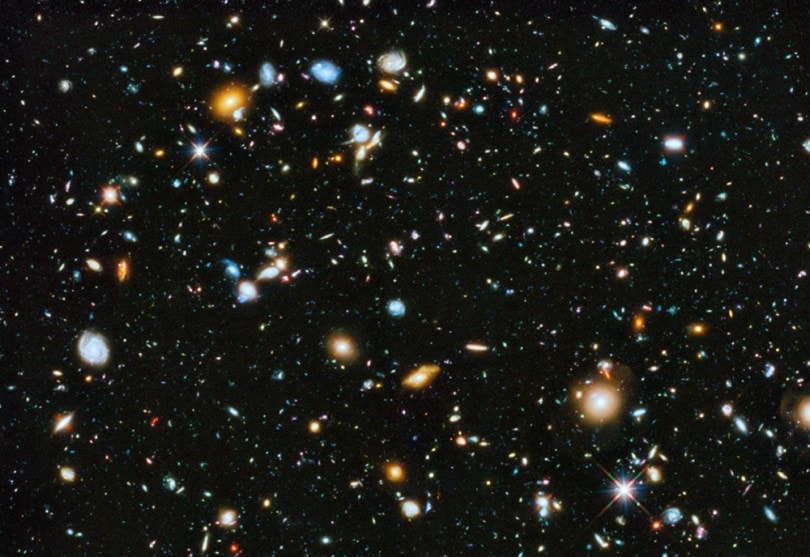
How big is the universe? While it is generally known that the universe is very big, the latest science reveals that its true size defies all comprehension.
By the end of this article, you will understand why the universe is so big, it guarantees the existence of aliens, mirror Earths, and even copies of you living in the distant past and far future.
Contents
Historic Views
Not long ago, people had a limited conception of reality. Five-hundred years ago most believed that Earth was the only world. But with new discoveries our picture of reality grew.
In time we came to understand other planets are whole worlds like Earth. A bit later, we learned stars are distant suns. Only in the last one hundred years has our conception of reality grown to include many galaxies, many Hubble volumes, many Big Bangs, and most-recently the idea of many universes.
Earth is the only World (Ancient Times)
The Greeks spoke of a celestial sphere, the old testament of a firmament in the sky — rigid canopies, either a sphere or dome, that surround the Earth and to which the stars are affixed.
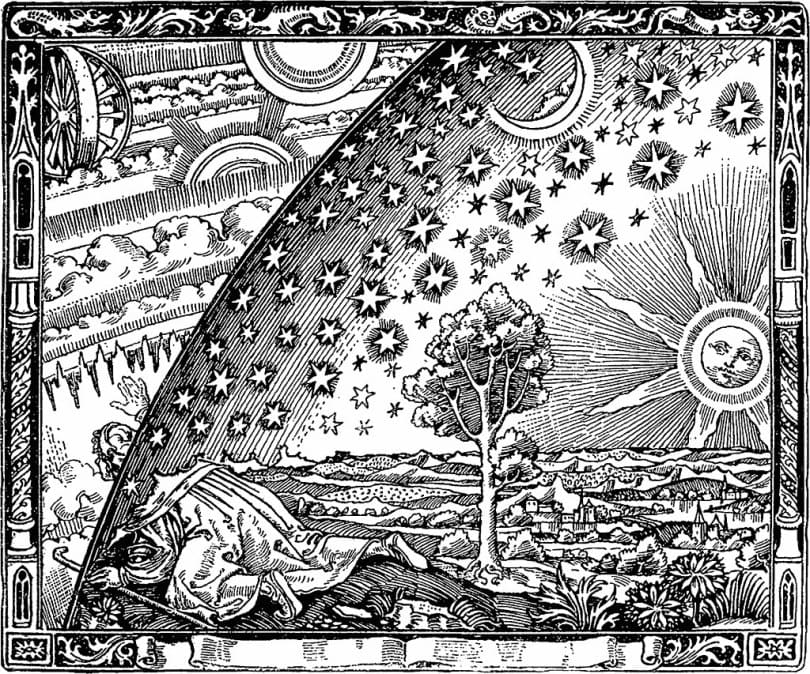
Before Newton, no one understood that gravity acts universally. Rather, gravity was seen as a force that drew everything to the center of the universe (where Earth was centered).
Accordingly, other worlds were impossible — there would be no force to hold them together.
Though five other planets were known to the ancients, they were not considered worlds. They were seen as celestial entities (or Gods) that moved across the backdrop of the fixed-stars. The word planet is derived from this phenomenon — ‘planetos‘ being Greek for wanderer.
Our World is one of Many Planets (1543)
Five-hundred years ago, Copernicus developed a model of planetary motion that assumed Earth and the planets moved around the Sun. Earth was no longer a lone world, but one among five others known at the time: Mercury, Venus, Mars, Jupiter and Saturn.
But people couldn’t handle expanding reality from one world to six. The Church classified the idea as heresy and in 1616 compelled Galileo to recant under the threat of torture and execution
The threat was not to be taken lightly. The Church had just burned Giordano Bruno at the stake in 1600, partly over his belief that stars are distant suns and that other planets might harbor life of their own.
Our Sun is one of many Stars (1838)
Under Copernicus’s model, stars remained as objects that adorned the celestial sphere. The only difference was that this sphere now encased the solar system rather than Earth.
TWINKLE, twinkle, little star, How I wonder what you are!
When “Twinkle, Twinkle, Little Star” was published in 1806, it was not just children who wondered what stars were. It was a genuine mystery to science.
It was not until 1838 that Friedrich Bessel found the first evidence that stars are distant suns; or more accurately: that our sun is a nearby star. He used a simple method to prove this: parallax.
Hold up your index finger and look at it with one eye closed. Then switch: close one eye and open the other still looking at your finger. As you flip back and forth between eyes, your finger seems to shift in its apparent position. That is parallax, and the amount of shift can tell you how far your finger is from your eyes.
Bessel, rather than use the distance between his eyes, used the distance across Earth’s orbit.
He looked at the apparent position of the same star half-a-year apart. In this time Earth travels 2 AU (roughly 185 million miles) from where it was six months prior. This provided sufficient distance for Bessel to detect a Parallax effect for a few of the closest stars. From the shift he determined how far away those stars are.
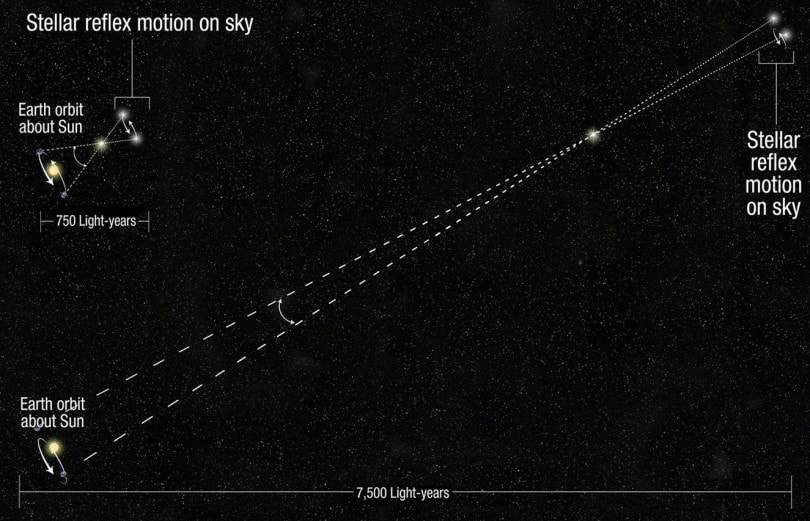
The distances Bessel obtained from this method were enormous. Even the closest stars were many trillions of miles away. Moreover, each star sat at a different distance. This blew apart the idea of a celestial sphere.
When Bessel estimated how brightly our sun would appear at these distances, he found it in line with the brightness of the stars. This was the first evidence that vast numbers of star systems fill our reality.
Perhaps each star had its own planets, as Bruno hypothesized centuries earlier. Our concept of reality grew.
Our Galaxy is one of Many Island Universes (1920)
At the start of the 20th-century telescopes remained near-sighted compared to those of today.
The best telescopes could only see stars within the nearest 10,000 light years (about 10% of the way across the Milky Way Galaxy) — our vision constrained to the local backwater of the galaxy.
We had no idea there were other galaxies. Scientists thought the Milky Way constituted the entire universe.
Nearly a century passed since Bessel’s discovery. Our picture of reality was due for another adjustment.
At the time, there was a debate concerning what these spiral arm nebula really were.
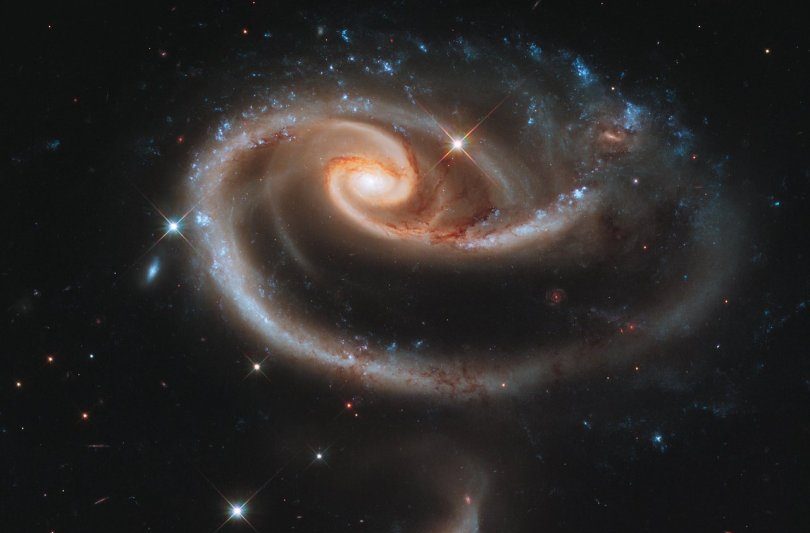
Most astronomers considered spiral nebula to be clouds of gas. Their name ‘nebula‘ is even Latin for cloud.
A few upstarts subscribed to a fringe idea. They believed these gas clouds constituted entire ‘Island Universes‘ — vast assemblages of stars like our own Milky Way.
In 1920, Edwin Hubble measured the Doppler effect on the light from these ‘gas clouds’. He found them fleeing from us at speeds so great that they were not gravitationally bound to our galaxy. In other words, if they haven’t already left our galaxy they soon would.
This evidence shifted the debate in favor of the Island Universe Theory, which is today just the standard idea that there are vast numbers of galaxies.
Hubble also found that galaxies move away from each other at speeds proportional to their distance. This strongly suggested space itself is expanding. Rewinding time, everything would be closer together.
This finding set the stage for the next debate in cosmology.
The Modern View
The Observable Universe is tiny part of the Whole (1927)
If space is expanding and making everything drift apart, then earlier everything would be closer together. Rewind the clock far enough and everything would be squished together at an incredible density.
In 1922, Alexander Friedmann showed how Einstein’s equations of General Relativity could account for an expanding universe. In 1927 Georges Lemaître connected the idea with Hubble’s discovery of expanding space. Lemaître called it The Hypothesis of the Primeval Atom. Today we know it as the Big Bang Theory.
Most scientists found the idea of an abrupt creation event inelegant and preferred the Steady-State theory.
According to this view, the universe was infinitely old, and always expanding. But if new space could be created, why not matter? Steady-State theory supposes that in the wake of newly minted space, new matter is continually created and new galaxies perpetually form to fill the void created by the expansion.
Ancient Radiation
This led to a battle between Big Bang proponents and Steady-State theorists.
Both sides lacked evidence to conclusively settle the matter. The debate raged on for decades. But in 1964 evidence finally came in. The Big Bang won.
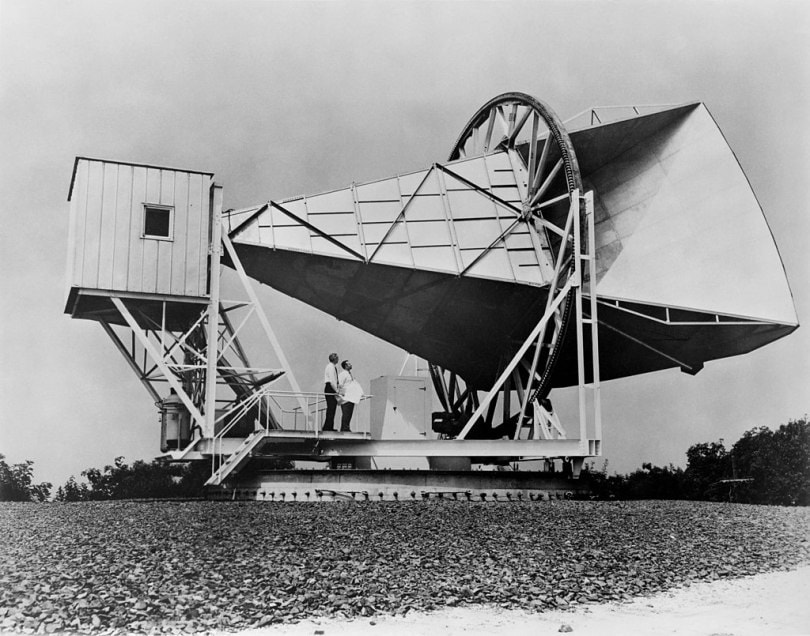
Two radio astronomers from Bell Labs, Arno Penzias and Robert Wilson found a persistent interference in the microwave frequency, a cosmic hum that seemed to emanate equally from all directions in the sky.
With the aid of physicists from Princeton, they determined the signal had all the predicted characteristics of thermal energy left over from the Big Bang. For their discovery, the pair won a Nobel Prize.
An untuned television set can also detect this signal. About 1% of the static appearing on the screen is due to this radiation. You are seeing energy that traveled for billions of years from the farthest reaches of the observable universe. Only a rare few of these particles are fortunate enough to meet their end on your antenna.
Given the speed at which galaxies are flying apart, we can estimate the Big Bang occurred 13.8 billion years ago. We usually consider ourselves as living in the second millennium, in actuality we’re in the 13,800,000th!
Where the Big Bang Happened
If the universe began a finite time ago, does that imply it has a finite size? Not necessarily.
The idea that a finite age implies a finite size stems from a common misrepresentation that the Big Bang emanated from one particular spot. In truth, it happened everywhere in space, all at once.
If you picked any spot in the universe, the Center of the Milky Way, a distant galaxy, even your own bedroom, you will find in rewinding the clock that all surrounding matter converges there. But the same is true for any point you choose.
Rewinding time, the universe was hotter and denser, but importantly, it was equally hot and dense everywhere. The Big Bang didn’t only happen somewhere far away, it happened right here — in the very space you now occupy. 13.8 billion years ago a plasma filled this spot. And it was so hot that nuclear fusion occurred.
The very space you are in now was once as scorching as a hydrogen bomb.
Fortunately, space has expanded and cooled a lot since then. It is now an average of just 2.7°C above absolute zero. The reason space is not zero degrees is due to the residual warmth of the Big Bang.
The Size of the Bang
Given the finite age of the universe, we can see only as far as light has been able to travel in 13.8 billion years.
This constitutes the entirety of the observable universe. But the observable universe is not the whole; the observable part constantly grows as new light from ever-more distant locations enters view.
So how big is the universe according to the Big Bang theory? How could we ever measure it?
Fortunately, Einstein’s General Relativity provides a way to measure the size of the universe. Even better, it works without having to travel to the far reaches of the universe.
It works a bit like measuring the size of the Earth using a level.
General Relativity says that if the universe is finite then space will be positively curved. It is analogous to how the surface of a planet is curved. Small planets have more curvature, larger planets have less.
In principle, you can measure the size of the Earth without leaving your home.
All you need to do is measure the curvature of the surface of water in a container. It’s tiny. Across the surface of a 2 meter bath tub, the surface curves by 0.3 microns. Over a mile it would curve just 8 inches.
Cosmologists have measured the curvature of space. The universe appears flat to within the limits of our measurement capability (within 0.4%). Given this, we know the whole universe must stretch at least 250 times farther than we can see. However, we know no upper-bound to how much farther it might go.
If the width, height, and depth increase by a factor of 250, then the volume increases by 250^{3} = \text{15,625,000}. This means the whole universe is at least 15 million times bigger than the part of the universe we can see.
Within our observable universe, our telescopes can see hundreds of billions of galaxies, each with hundreds of billions of stars. Based on the curvature measurements, what we can see is just a small speck of a much larger, potentially infinite, universe.
The lack of detected curvature implies space extends a minimum of 11 trillion light years in every direction. Given that the big bang happened everywhere at once, we can’t say how far space ultimately continues. For all that is presently known, it may go on forever.
Yet a new theory, one that fills gaps in the Big Bang Theory, suggests reality is vaster still.
The Big Bang is one of Many (1980)
The Big Bang is a successful theory due to its many verified predictions. It explains the appearance and ratios of chemical elements in interstellar space, and moreover we can actually see the big bang with our telescopes.
Given the finite speed of light, the farther a telescope peers into space, the farther back it looks in time. We see the moon as it was one second ago, the sun as it was 8 minutes ago, the closest stars as they were years ago, and nearby galaxies as they were millions of years ago.
Our radio telescopes can look far enough to see the universe when it was just 400,000 years old. At this point in time space was filled with an orange afterglow remaining from shortly after the universe became transparent.
This period in time is known as the recombination era. But 400,000 years after the big bang, the whole sky would appear orange, as bright as the surface of a star. Filling the sky, it would quickly roast us.
Fortunately, the Doppler effect of expanding space has reduced this orange light to the much less energetic microwave range, losing over 99.9% of its energy. The universe fell in temperature from a searing 3000 Kelvin to a bone-chilling 2.7 Kelvin.
Cosmic Inflation
Despite its successes, there were lingering mysteries not addressed by the original Big Bang theory:
- The Homogeneity Problem: Why is the background radiation so uniform in temperature?
- The Flatness Problem: Why is there so little curvature to space?
- The Monopole Problem: Where are all the magnetic monopoles?
In 1980, Alan Guth, Alexei Starobinsky, and Andrei Linde worked out a theory known as Cosmic Inflation. It is an extension to the Big Bang theory which addresses all these problems. Further, it explains why the universe went BANG in the first place and why the universe is still expanding to this day.
The theory makes a modest assumption, which is also backed up by particle physics: that the vacuum contains energy. If vacuum energy is non-zero, General Relativity predicts space will expand on its own. The greater its energy, the faster it expands.
In answering the previous questions, Inflation trades four problems for one. It also tells where all the space, matter and energy comes from. The only problem left is from where did this little piece of high-energy, self-inflating vacuum originate?
Inflation supposes that the vacuum energy was once greater than it is now. So great, in fact, that this high-energy vacuum would double in about a trillionth of a trillionth of a trillionth of a second.
But this high-energy state is unstable and can decay, much like a radioactive particle. When the vacuum decays, its vast energy gets dumped into space. This energy manifests as spontaneous particle creation. The thermostat is raised and the temperature of the universe soars to 10^{27}°C.
If inflation happened, then for it to be consistent with observations it must have gone on for at least 10^{-32} seconds. In this time the spatial doubling causes space to stretch by a factor of 10^{26} in every direction — an increase in volume by a factor of 10^{78}. But inflation could have gone on for much longer.
Alan Guth thinks it is reasonable to suppose that inflation went on for twice the bare minimum time. That implies the whole universe is 10^{78} times bigger than the part we can see.
Once the vacuum decays to a lower energy state the rate of expansion slows. This is why the universe now doubles in volume after billions of years, rather than in a fraction of a nanosecond.
Eternal Inflation
Observational evidence supporting inflation came in 1992, with data from the Cosmic Background Explorer (COBE) satellite. The patterns of variation seen in the radiation are consistent with cosmic fluctuations occurring at all scales of space as the universe rapidly expanded.
The rapid expansion of space turned the observable universe into a sort of giant microscope. The pattern of radiation and the distribution of galaxies across the night’s sky are gravitational imprints of quantum fluctuations that occurred at the microscopic scales when the universe was small. Following inflation these variations were magnified to galactic proportions.

There is however, a shocking consequence of inflation. Once it begins, it never fully stops. This is the idea of Eternal Inflation. Inflation is eternal because for inflation to start, the high-energy vacuum must grow faster than it decays. But if it grows faster than it decays it leads to a runaway reaction that never ends.
Consequently, there remain parts of the universe that are still inflating rapidly. That means parts of the universe have for billions of years been growing at fantastic rates. Whenever and where ever the vacuum decays to a lower energy state, the result is another Big Bang and a new region of slowly expanding space.
The total number of Big Bangs is therefore unbounded, and grows exponentially with time. In a way, Steady-State theory is vindicated. New matter and energy are created in the void of rapidly expanding space, it just doesn’t happen in the slowly expanding space of our neck of the universe.
In summary, if eternal inflation is right, then our Big Bang was just one of an infinite number of Big Bangs.
Current Speculations
Thus far we have covered only established theories with direct observational confirmation. These ideas are part of standard science and are described in today’s high school textbooks.
Nonetheless, these ideas imply a reality unbelievably bigger than the one accepted just 50 years ago.
New speculations make even the exponentially growing number of Big Bangs seem puny in comparison. Though not confirmed, there are good reasons to believe these ideas, or something like them, hold water.
Our Physical Constants are one of Many
String theory is a candidate quantum theory of gravity. Its key idea is that particles are not points or balls, but rather tiny strings of energy vibrating in many dimensions.
Developing a quantized theory of gravity is necessary if we are to ever understand what happens inside black holes or during the incredible densities near the beginning of the big bang. Such an understanding is also necessary to create the fastest physically possible computer — the black hole computer.
The only problem: string theory doesn’t have one unique solution. In 1987, the Nobel prize-winning physicist Steven Weinberg worked out that string theory contains at least 10^{500} possible solutions. Each one has a different set of physical properties.
Later investigations raised this estimate to at least 10^{\text{272,000}} solutions. The true number of allowed solutions may be infinite.
While there is no experimental verification of string theory, aside from its prediction of gravity, there is strong evidence to believe that many different systems of physics, each having different parameters, are real.
The strongest evidence comes from the apparent fine-tuning of the constants of physics to support life. Chief among these is the strength of the vacuum energy. If it were just slightly greater, space would have expanded too fast for galaxies or stars to form. The universe would remain an ever-expanding haze of gas.
But it’s equally fortunate that the energy was not zero or negative. In that case the universe would have gravitationally collapsed billions of years ago, before life could arise. The vacuum energy had to be balanced just right, with a positive strength extremely near to zero, but not zero or negative.
The odds that it would have a value in the right range by random chance is about one in 10^{120} — about the same odds as winning a national lottery 15 times in a row.
The conclusion it leads to is that not only is our big bang one of many, but our own physical forces and constants are one of many. String theory implies a vast landscape of possible universes each with their own unique physics, and given fine-tuning, there’s reason to believe they are real.
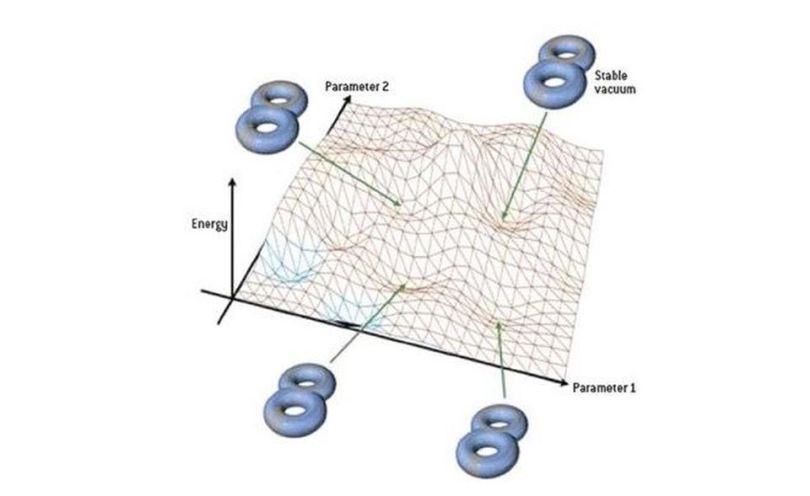
We imagine our universe to be unique, but it is one of an immense number—perhaps an infinite number—of equally valid, equally independent, equally isolated universes. There will be life in some, and not in others. In this view the observable Universe is just a newly formed backwater of a much vaster, infinitely old, and wholly unobservable Cosmos. If something like this is right, even our residual pride, pallid as it must be, of living in the only universe is denied to us.
Carl Sagan
We are now led to wonder: is there anything special about the equations of string theory? Why should they be blessed with the gift of existence while other equations describing other universes are not?
This thinking led to the reality-shattering idea that perhaps every possible structure exists.
Our Physical Laws are One of Many
In 1996, the cosmologist Max Tegmark published his Mathematical Universe Hypothesis (MUH).
It is the idea that physical existence is merely mathematical existence. This makes physical existence redundant, as for every physical object there is already a corresponding mathematical object of an identical structure.
Our universe for instance, which we consider a physical object having a physical existence might just be a mathematical object having a mathematical existence.
After all, how could we ever tell the difference when the two objects are otherwise identical?
These ideas are more than idle speculations. The MUH explains several features of reality. It answers:
- Why the laws of physics are so mathematical
- Why the laws are so comprehensible
- Why the laws seem fine-tuned for life
The logician Bruno Marchal, the computer scientist Russell Standish, and the physicist Markus P. Müller have each independently demonstrated how the existence of an infinite and comprehensive reality directly leads to physical laws that are probabilistic and contain irreducible randomness.
This is exactly what we find when we look at our own physics. The laws of quantum mechanics make only probabilistic predictions, and manifest a fundamental randomness that cannot be predicted, even in principle.
Just as string theory predicts gravity, MUH might account for some or all of the features of quantum mechanics.
Some people object to the MUH on the basis that objects in math, unlike in physics, are changeless.
But this overlooks two important facts. The first is that any object in math can model time by adding a dimension through which different states are ordered. The second, is that modern science suggests time and change are not actual features of our physical universe, but apparent ones. See “What is time?“.
MUH inevitably leads to deep philosophical questions, like why does anything exist?
Given that we just witnessed evidence of a vast, possibly infinite, reality, it becomes a little easier to believe that reality could be a bit bigger than we originally thought. Reality might just include everything that can be.
Conclusions
Compared to the time humans have walked the earth, we’ve undergone a radical shift in a short period. We now understand reality and our place in it very differently than in times past.
In the words of Sagan, our time is marked by “successive debunkings of our conceits.“
Our world is the only worldOur sun is the only sunOur galaxy is the only galaxyOur big bang is the only big bang- Our physical constants are the only physical constants ???
- Our physics equations are the only physical equations ???
Given the trend, it would be wise to bet on reality being bigger than most people believe.
How Many Stars
For most of history, humans believed in the existence of only one Sun. Ancient peoples held the sun in the highest esteem. It provided warmth, protection from predators, and sustenance through our crops.
The Egyptians consider the sun god Ra to be king over all the others. Even in modern times, we’ve named the first day of the week in its honor.
But in a few human generations, we’ve gone from a belief in a singular sun to understanding that our galaxy is filled with 100,000,000,000 other suns — a 1 followed by 11 zeros (or 10^{11}).
| Year | Concept of Reality | Number of Suns |
| 1543 | Solar System | 1 |
| 1838 | Milky Way Galaxy | 10^{11} |
| 1920 | Observable Universe | 10^{22} |
| 1927 | Universe Size implied by Flatness | 10^{29} |
| 1980 | Universe Size implied by Inflation | 10^{100} |
| 1987 | Multiverse Size implied by String Theory | 10^{600} |
| 1996 | Concordance Model, Eternal Inflation, Infinite Landscape, or MUH | \infty |
There are people alive today who were born at a time before we understood there are many galaxies. Learning that there were other galaxies with their own stars expanded our picture of reality to include 10^{22} suns.
General Relativity allowed us to estimate the size of the universe from the curvature of space. This implies a universe at least 15 million times larger than what our telescopes can see.
Not to be outdone, Inflation suggests a universe of at least 10^{78} times the volume of the space we can see, giving us a whopping 10^{100} (a googol) stars.
Wading into more speculative physics, such as string theory, we find there might be 10^{500} times as many universes, each with their own unique physical constants, adding another 500 zeros to the googol inflation gives us.
Of course all these numbers are lower-bounds. The standard model of cosmology, called the Concordance Model, assumes a flat and spatially infinite universe. This alone gets us to an infinite number of stars.
If the universe is not spatially infinite, then eternal inflation does the job. An infinite number of big bangs occurring for all eternity has no trouble producing infinite stars.
Even if the universe is not spatially infinite, and even if Inflation somehow stops, an infinite landscape from string theory or the MUH also fill reality with infinite stars.
The consequences of an infinite reality cannot be understated.
Implications of an Infinite Reality
Surprising consequences follow when reality is sufficiently big.
We’re Not Alone
The first and most obvious consequence of a huge reality is that it guarantees the existence of extraterrestrial life. Though we have not spotted little green men in our telescopes, our instruments have nonetheless indirectly proven their existence.
The COBE satellite, looking at patterns in radiation from the big bang, provided evidence for Inflation. Inflation leads to a reality 10^{78} times bigger than previously assumed, and more likely than not, implies an infinite space populated by infinite Big Bangs.
If life is possible, inflation ensures it will recur an infinite number of times in an infinite number of places.
You have Doppelgangers
If space is infinite, then patterns in the arrangements of matter eventually repeat.
In fact, Max Tegmark calculated that an exact copy of you, reading an exact copy of this article written by an exact copy of me can be found just 10^{{10}^{28}} meters from here.
The physical situation is analogous to the infinite series of digits found in the number Pi:
\Pi = 3.1415926535 89793238462643383279\dots
Among Pi’s infinite digits, you can find any sequence: your zip code, your phone number, encodings of any book, picture or movie. Every finite sequence of digits exists somewhere in Pi.
On average, to find a sequence that is n digits long, you need to look through 10^{n} digits to find the next occurrence. A 5 digit ZIP code should appear about once in every 10^{5} = \text{100,000} digits of Pi.
Every finite sequence recurs an infinite number of times precisely because Pi goes on forever. Similarly, should space go on forever then every possible finite arrangement of matter occurs in an infinite number of locations.
So should space be infinite, there are infinite copies of you, Earth, and even exact atom-for-atom copies our whole Milky Way Galaxy.
What has Happened Before, will Happen Again
Given infinite Big Bangs, even rare and uncommon events, such as the entire history of life on Earth as we have experienced it will not only happen again, but have happened before.
In an eternally inflating universe, anything that can happen will happen; in fact, it will happen an infinite number of times.
Alan Guth
According to inflation, this isn’t the first time you have lived your life. Nor is it the last.
You will live again exactly as you have now, and also you will live every possible variation of that life.
But are they all you?
Does God Exist?
If the MUH is right then everything exists. The set of all mathematical structures includes all possible universes and all possible beings. Some of those universes will possess unlimited computational resources.
Using these resources, intelligent life or intelligent beings could simulate any universe in exact detail. In effect, they would possess the power to generate reality and create universes through computer simulation.
For a more thorough consideration of this question, see “Does God Exist?” and “Are we living in a computer simulation?“


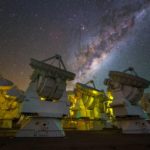

I am an 82 year old layman, educated but not in a scientific field. For many years I have doubted the Big Bang theory and Darwinian theory simply based on logic. On the subject of the Cosmos, I doubt that infinite mass could be contained in something as small as a single atom, which is what the Big Bang theory proposes. Also infinite temperature suggests that explosions would have occurred at much lower temperatures which also suggests that matter would never have collapsed to such a small size before exploding. It should have exploded at much lower temperatures. Then there is the theory that all galaxies are moving away from each other. If that is true, how could the Milky Way galaxy and the Andromeda galaxy ever collide? I have many many more questions and hope, one day, to get answers.
I truly enjoy reading scientific articles like this one and will continue to be surprised at new discoveries for as many years as I have left.
Dear Mr. Valade,
Thank you for your comment! Your intuition was right for doubting the Big Bang model as originally described. Most scientists now doubt the universe was ever at a point of infinite density and at zero volume. Here are two videos I recommend which explain why that original conception is probably wrong:
https://www.youtube.com/watch?v=K8gV05nS7mc
https://www.youtube.com/watch?v=JDmKLXVFJzk
A new theory, developed in the 1980s, called Inflation, modifies the picture of the earliest stages of the universe. It says there never was a point of infinite density and temperature. I have an upcoming post which will talk more about Inflation.
As to why nearby galaxies can still collide: this comes down to the expansion rate. The rate of expansion of space between two objects depends on the distance between them. This is defined by the “Hubble Constant” which works out to: 342 mph per 1,000 light years
So two things separated by 1,000 light years will see the space between them grow at 342 mph. If there are 2,000 light years separating them, then the space between them expands at twice this rate, 684 mph.
The Milky Way and Andromeda are about 2 million light years apart, so the space between them will expand at a rate of 684,000 mph. But due to Gravity, we are falling towards Andromeda at a faster rate than the space between us and Andromeda is growing. Therefore the distance between us is closing. This can happen when galaxies are close enough or fast enough.
I hope this answers your question. Thank you for asking!
Such a beautifully written and illustrated article. Thank you so much for your efforts. ?
Paul T…..
Thank you Paul! I appreciate your sentiments.
A New Universe to Explore Alone
Over 30 years alone, I have free research in my Library without help from the government. Finally I found fulfillment in the Universe Creations, Creator & Cosmology discoveries everything. It’s finding its own theories with the philosophy of Science and its natural way to understand real history of the Universe & Cosmology. Correct Understanding (No need equation) Scientists, Researchers, Philosophers, Teachers, Students, Priests, Minded people, Generations & Observatory Scientists found- Education innovates- understanding the Universe & Real Cosmology.
See URLs version: In order of merit found realism- Who is the right one for World frontier & Higher Degrees of World fore-knowledge of astronomy, astrophysics & Cosmology with Infinite & Infinitesimal! https://www.linkedin.com/pulse/new-universe-explore-alone-shahidur-rahman-sikder/?published=t
Finally a question arisen- If Allah/God created everything, who created Allah/God? In that question there is no answer because it is not possible to take back our imagination power before it. So it is only one answer to this question: that the power himself is standing behind it. God does not exist but we found the Allah/God of Partially.
Fulfillment History of the Universe & Cosmology- See in my Book at: https://www.amazon.com/dp/B07S42JPDS
I am seeking who can give me strictly the right note on the thesis?
Certainly very useful article for school kids and laypersons as well. However, you should reconsider the history of cosmological ideas. The most of scholars don’t go beyond the biblical and Eurocentric views.
How was the universe created and how big is the universe are certainly very ancient. The ancient Vedas seem skeptical about the cosmological ideas. https://en.m.wikipedia.org/wiki/Nasadiya_Sukta. Carl Sagan also has mentioned about it. But in Brahaman Period (1000 BCE to 600 BCE) the brahmins claimed the universe was created by Brahama. In this period there were several schools of thought in India. Here, I should tell just major ones; eg. Jain believed the universe is eternal, without begining and without end. So no creator of the universe. There were few hardcore Atheists who believed there is no universe or extraterrestrial beyond Earth. In fact, some Atheists were so silly that they even didn’t believe this is earth. Buddha himself called analytic or rationale. He followed middle path and abided two extremes. He can be called an early agnostic Atheist. He seems not so interested in cosmological metaphysics but when he felt necessary he opined. He believed that the cosmos has no creater, the universe goes through the cycles of contractions and expansions after Aeons and Aeons without the intervention of God or Brahma. However, he kept silent to reply for the questions like the universe is eternal or not, finite or infinite. You can read here, https://en.m.wikipedia.org/wiki/The_unanswered_questions. According to a story, a god told Buddha, he was a skywalker at the speed of fastest arrow, he tried to find out the edge of the cosmos but he died on the way without reaching it. Know that life of a god in the space means much more than human life. One eyeblink of god means thousands years for human life and gods life span is many thousand years. Buddha replied we are also made of star stuffs like four great elements, if these elements are annihilated we reach the state of Nirvana which can’t be explained with the human words of being and nonbeing or otherwise. That is why, he kept silent in above questions. Even though, Buddha used often the four great elements but he also used atom. However, it is not clear that by atom what did he meant! Later, his early disciples opined that in one cubic inch (finger tip) there are 576, 108, 288 atoms.
According to recent archaeological report and I also put the date of Buddha, before Cyrus II and Thales.
Hi Shahidur Rahman Sikder,
I appreciate your views and curiosity! I have some upcoming articles planned which are dedicated to the question of why anything exists at all.
Thank you Ranjan Lekhy! I am glad you find the content useful. I appreciate your insights regarding Hindu, Jain, and Buddhist views on these questions.
I have an upcoming post on about the scientific support for different conceptions of the afterlife. It gives more attention to the philosophies of these religions.
The stars shine many light-years apart; hence who is Man to ponder communicating with those, yonder.
Hi Boghos Artinian,
The distances between stars are great on the scales of human lifetimes, but they are short on geological times. The sun and Earth have already lapped the Milky Way Galaxy 18 times. If the first technological species had the will, they could fill the galaxy in a million years — a blink of the eye in terms of how long it takes intelligent life to arise in the first place.
Given that, it cannot be ruled out that intelligent life already fills the galaxy. Perhaps such life maintains a presence in every star system, or perhaps only those systems bearing life that is nearing that technological potential. If you haven’t seen it already, you might appreciate the article on this subject: https://alwaysasking.com/are-we-alone/
for what i research about there is single energy at rest which spread different frequency around the universe to make all exist possible and sensible nothing form indepently.iwant to know are we from atom
Hi Abisihan Oosman,
I have just published a new article on this very subject It provides a possible explanation for what makes the universe exist:
https://alwaysasking.com/why-does-anything-exist/
Before inflation started were a total number of zero universes in a volume which is 0 was 0 because 0 times infinity is 0. But as soon as inflation started the total number of bubble universes were infinite in a volume which was infinite because any non zero number times infinity is also infinity. The space between bubble universes expands exponentially and in those regions of expanding space between bubble universes new bubble universes continue to form and this process will go on forever. So as soon as inflation started there was already a volume of false vacuum background which was infinite. 1/3 of that volume decayed and produced bubble universes and the other 2/3 of that volume expanded and doubled in size. Then 1/3 of that expanded and double volume decayed and produced more bubble universes and the 2/3 of that expanded and doubled volume doubled and expanded again and this process will go on forever. The total number of bubble universes was already infinite as soon as inflation began but as inflation false vacuum expanded it made the distance between bubble universes expand and will create number bubbles in that expanded region of space and this process will go on forever. Max Tegmark’s says you can finite an infinite volume inside a what a subatomic particle looks like from the outside without affect the exterior space. At first it may seem like this model of a multiverse only works if each universe is finite in size. After all, an infinite universe wouldn’t have an edge beyond which other bubble universes could be found, right? Actually, no. It is possible for a universe to have an infinite volume but be contained within a finite edge. As it also turns out, the nature of quantum fields can be determined at an infinite distance away from some starting location. Solving the formulas of quantum field theory at that distance allows you to determine the quantum fields behaviour at the 2D boundary surrounding an infinite volume. Mathematically, you can fit an infinite volume within the bounds of a finite 2D edge using tessellation and hyperbolic geometry, which you can learn about from the video above. Doing so allows you to fully describe an infinite universe by examining its finite edge. I have a video here about it https://www.youtube.com/watch?v=tJevBNQsKtU&t=1s
The same principle would apply to the false vacuum background of an eternally inflating multiverse. Am I right about eternal inflation what I have said about eternal inflation.
Hi James,
It looks like you’ve done quite a bit of research on these topics recently. I commend you for that. 🙂 Mathematics does provide many ways of “compactification” ( https://en.wikipedia.org/wiki/Compactification_(mathematics) ) that enable infinite things to be fit into finite spaces. As to how this works in inflation, Alan Guth has describes it in terms of the geometry of spacetime — where the infinite time dimension the universes can be partially used to fit the infinite space: https://www.youtube.com/watch?v=rfeJhzPq3jQ I hope to cover these ideas of inflation in more depth in an article “Does space go on forever?”
if there are an infinite number of ways that the entropy of inflationary perturbations (uniform mass of matter and energy that existed milliseconds after the big bang) can be different and an infinite number of e folds of the slow roll inflation can be different, if there is an infinite number of ways that the value of entropy at the big bang and value of mass at the big bang can be different, If there are an infinite number of ways the average density of normal matter can be different, If there are an infinite number of ways the density of dark matter can be different, If there are an infinite number of ways that the density of dark energy can be different, If there are an infinite number of ways that the cosmological constant can be different, if there are an infinite number of ways that the ratio of dark energy to dark matter to normal matter can be different, If there are an infinite number of ways that the total mass density of the universe can be different, if there are an infinite number of ways that the value of entropy and density at the big bang can be different, If there are an infinite number of ways that the laws of physics can be different, If there are an infinite number of ways that the constants of nature are different, If there are an infinite number of ways that the string theory vucua can de different, If there are an infinite number of ways that the string theory geometry can different and finally if there is an infinite number of ways in which the strength of the inflationary field in which new universes are created are different then how is it possible to live again and the history of the universe to repeat again if cosmic inflation is true? You said with string theory, the laws of physics and the constants of nature as long as there is no detectable difference you will live again and the history of the universe will repeat again but how about the other criteria’s such as the density of the universe and the entropy of the universe at the big bang?
Hi James,
Good questions. It’s always difficult reasoning about infinities. I am actually planning an article on infinity. It’s a very complex topic, for there are an infinite number of different kinds of infinity (see https://weta.org/watch/shows/infinite-series/hierarchy-infinities ). That said, the way I view it, is that if nature can cause one universe with our set of conditions to exist once, then why should nature not be able to cause such a universe with our set of conditions to exist a second time? It’s not a proof by any means, but I have never seen an argument for why whatever process caused this universe to begin in the first place could not happen again. If you see the “Why does anything exist?” article, it leads to the idea of a reality that is infinitely repeating, and varied, much like a fractal ( https://en.wikipedia.org/wiki/Mandelbrot_set ) going on forever with infinite apparent complexity.